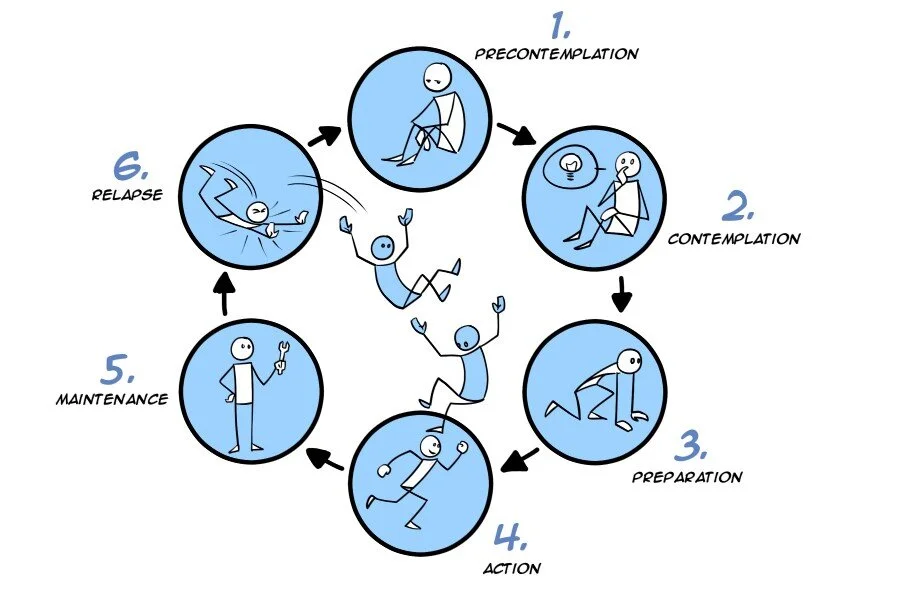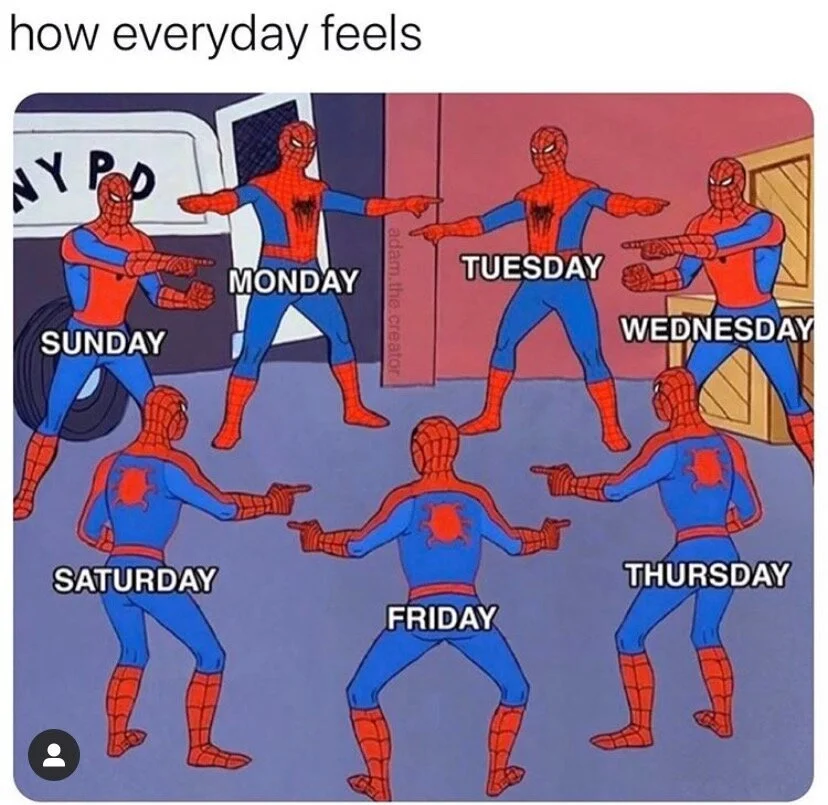Start Healthy Habits That Actually Stick
Have you been thinking that it’s time for you to be more active or eat less unhealthy food? We all get it—it's hard to break out of bad habits and stick to good ones. According to NIH, picking up or changing your habits is a journey with different stages that involve: pre-contemplation, contemplation, preparation, action, and maintenance, relapse. Let’s go over these six stages and see how we can tackle each stage to make healthy habits a part of your daily routine.
cycle of change model from blog.braive.com
Stage 1-2: Pre-Contemplation & Contemplation
Bad habits are hard to change because we are in our comfort zone with no intention to change any behavior. The first step to any change is noticing or realizing that a change needs to be made. To move on to the contemplation stage, you need to feel motivated to improve your personal well-being with healthy habits and changes. Yet it’s normal to not know how to start. A way to set up a plan to overcome roadblocks is to learn about your “Tendency.” The Four Tendencies by Gretchen Rubin is a framework that answers “How do I get myself to do what I want?” by revealing whether a person is an Upholder, Questioner, Obliger, or Rebel. Understanding our “Tendency” can help us understand how we respond to expectations and how we can achieve our goals more likely.
Take the quiz to identify your Tendency here.
Stage 3: Preparation
After learning more about your Tendency or personality, you feel ready to make plans and think of specific goals that are feasible for you. First, list out the roadblocks that might stop you from changing your habits. Then, think of possible solutions that can overcome these roadblocks. Here are some common roadblocks and solutions from NIH:
I don’t have time.
You always have time if you make the time by prioritizing your new healthy habits. Fit in physical activity whenever and wherever you can. Try taking the stairs, getting off the bus a stop early, or parking further to get some walks in. Set aside one grocery shopping day a week and meal prep healthy meals to freeze and eat later when you don’t have time to cook.
Healthy habits are too expensive.
You can walk around the neighborhood or local park for free, or utilize your school gym or track if you have the benefits. Buy groceries in bulk and when items are on sale. In many communities, there are food drives or food banks that offer free food on certain days. See if you qualify for Calfresh for other food stamp programs at your school or community to eat healthy while staying on budget.
I can’t make this change alone.
Get an accountability buddy or group to be active with you and keep you motivated. Try signing up for a fun fitness class or get your family or friends on the healthy eating bandwagon. Plan healthy meals together with your family or friends, even if it needs to be virtual meals at the moment. If you don't have someone to be your accountability buddy, join a Facebook social group! There are many local hiking groups where people will share hikes and fun places to work out.
I don’t like physical activity.
Forget the old notion that being physically active means lifting weights in a gym. You can be active in your own creative way, like dancing, skating, or gardening. Explore options that you haven’t tried and learn what you enjoy.
I don’t like healthy foods.
Try making your old favorite recipes in healthier new ways. You can trim fat from meat and reduce the amount of butter, sugar, and salt that you cook with. Start with small changes by using low-fat cheese or milk rather than whole-fat foods, or adding a cup or two of veggies to your meals.
• • •
Once you have a better expectation of how you will deal with your roadblocks, it’s time to turn your solutions into SMART goals. A SMART goal is one that is Specific, Measurable, Achievable, Relevant, and Time-Bound. Download this worksheet from Smartsheet if you need more guidance on setting up your personal SMART goals. Here are some examples of health and fitness SMART goals:
Goal
What makes it SMART?
Only drink boba twice a month.
It is more specific than just “eating healthier.”
Walk three days a week after dinner.
It is measurable compared to “walking more.”
Split my workout to 10 minutes in the morning, 15 minutes during lunch, and 20 minutes after work.
It is more attainable because I know I cannot commit to a 45-minute workout session with my current work schedule.
Attend yoga classes four days a week.
It is a goal that is relevant to my own interest as I care more about improving my mindfulness rather than losing weight.
Exercise for 45 minutes each day, four days a week by end of December.
It is time-bound as I have a time frame set to achieve my goal of losing weight.
Stage 4: Action
Now that you have a plan set, it’s time to take action. At this stage, you are making real changes to your lifestyle. It is important for you to track your progress, plan ahead for setbacks with your expected roadblocks, and not forget to reward yourself for your hard work. Especially during this pandemic time, it’s so easy to lose track of time and days!
Finding your personal way to track your progress can help you plan ahead for setbacks with your expected roadblocks. Having setbacks does not mean failure as the key is to get back on track as soon as you can. There are many creative tools out there to help you keep track of your progress or goals if you don’t like the traditional journaling way. Here are a few suggestions:
Strides for tracking your goals
Productive for tracking your habits
MyPlate for meeting healthy eating goals
Sleep Cycle for tracking your sleeping habits or improving your sleep quality
Screen Time (with iOS) for tracking your screen time and setting mental breaks from social media or games
Body Weight Planner for tailoring your calorie and physical activity plans
Set up a reward system that does not relate to food or unhealthy treats. Rewards don’t have to be big either, like giving yourself a grand vacation. It can be small comforting things like buying new workout clothes or gear to raise your spirit.
Stage 5-6: Maintenance & Relapse
You’ve come a long way to reach this maintenance stage. At this point, you should have kept your new habits up for more than 6 months. Along the way, you have had setbacks that lead you to the relapse stage, but you manage to continue to get back on track. Now is the time for you to keep things more interesting by exploring more ways to stay motivated and challenge yourself. Try revisiting your SMART goals and consider expanding them. As you keep finding ways to improve your routine, you will see that small changes can lead to big results.




